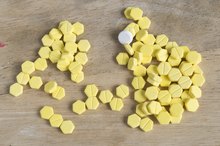3 Specific Uses of Enzymes in the Human Body
Enzymes are specialized proteins your body uses to carry out a wide variety of chemical reactions. Without enzymes, these reactions would not occur fast enough to sustain human life. Three of the many specific uses of enzymes in your body include food digestion, copying your genetic information to make new cells and generating energy.
Food Digestion
The food you eat must to be broken down into its component nutrients to be absorbed and utilized by your body. Digestive system enzymes belong to a class of enzymes called hydrolases. These enzymes trigger a reaction called hydrolysis, which breaks large molecules into smaller units. There are many different digestive enzymes to break down different types of food components. For example, enzymes called pepsin and trypsin digest dietary proteins. Another hydrolase called lipase is secreted by your pancreas and helps break down dietary fats. The enzyme amylase stimulates the digestion of dietary starch.
DNA Copying
Organic Compounds That Must Be in the Diet
Learn More
Your cells contain genetic material called chromosomes, each carrying an array of genes that encode your individual genetic makeup. This genetic material is in the form of a molecule called deoxyribonucleic acid, or DNA. When cells in your body divide, each newly created cell must contain an exact copy of your DNA. To carry out this copying, or replication, your body relies on specific enzymes. For example, enzymes called helicases and gyrases unwind the tightly coiled DNA strands so they can be copied. DNA polymerase enzymes participate in the actual copying process. DNA ligase enzymes are involved in finalizing the copying process.
Energy Production
Your body must generate energy to carry out all of its functions. Although blood sugar, or glucose, is the preferred fuel to generate energy, proteins and fats can also be used. These complex processes -- collectively known as cellular respiration -- rely on enzymes and generate molecules called adenosine triphosphate (ATP) that power your cells. For example, energy generation using glucose is called glycolysis. Each of the 10 steps in glycolysis involves a different enzyme. Each molecule of glucose broken down by glycolysis yields 2 ATP molecules. Examples of enzymes used in glycolysis include hexokinase, aldolase, enolase and pyruvate kinase. Other enzymes are involved in the generation of ATP from proteins and fats.
Enzymes and Human Health
Vitamins That Function As Coenzymes
Learn More
Many medical conditions are associated with enzyme problems. For example, a deficiency of the digestive enzyme lactase, which breaks down milk sugar, leads to lactose intolerance. A more serious deficiency of digestive enzymes can develop with inflammation of the pancreas, or pancreatitis. This condition is often associated with weight loss and malnutrition due to a reduced ability to digest foods consumed in the diet. Inherited disorders can also cause enzyme defects that may have catastrophic consequences. For example, children born with Tay-Sachs disease have a genetic abnormality with an enzyme called beta-hexosaminidase A. The impaired function of this single enzyme leads to destruction of nerve cells in the brain and spinal cord. Children born with this disorder usually die in early childhood.
Reviewed by: Tina M. St. John, M.D.
Related Articles
References
- The Cell: A Molecular Approach, 2nd edition; Geoffrey M. Cooper
- Biology; Martin Rowland
- Molecular Biology of the Cell, 4th Edition; Bruce Alberts, et al.
- Biochemistry, 5th Edition; Jeremy M. Berg, et al.
- Genetics Home Reference: Tay-Sachs Disease
Writer Bio
M. Gideon Hoyle is a writer living outside of Houston. Previously, he produced brochures and a wide variety of other materials for a nonprofit educational foundation. He now specializes in topics related to health, exercise and nutrition, publishing for various websites.









